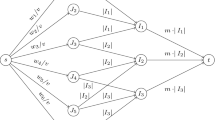Abstract
This paper is concerned with the implementation of parallel programs on networks of processors. In particular, we study the use of the network augmenting approach as an implementation tool. According to this approach, the capabilities of a given network of processors can be increased by adding some auxiliary links among the processors. We prove that the minimum set of edges needed to augment a line-like network so that it can accommodate a parallel program is determined by an optimal path cover of the graph representation of the program. Anoptimal path cover of a simple graphG is a set of vertex-disjoint paths that cover all the vertices ofG and has the maximum possible number of edges. We present a linear time optimal path covering algorithm for a class of sparse graphs. This algorithm is of special interest since the optimal path covering problem is NP-complete for general graphs. Our results suggest that a “cover and augment” scheme can be used for optimal implementation of parallel programs in line-like networks.
Similar content being viewed by others
References
J. R. Goodman and C. H. Sequin, Hypertree: A Multiprocessor Interconnection Topology,IEEE Transactions on Computers,C-30(12):923–933 (December 1981).
C. L. Seitz, The Cosmic Cube,Communications of the ACM,28(1):22–33 (January 1985).
C. H. Sequin and R. M. Fujimoto, X-Tree and Y-Components, inVLSI Architecture, (eds.), B. Randell and P. C. Trelevan Prentice-Hall International, pp. 299–326 (1983).
S. H. Bokhari, On the Mapping Problem,IEEE Transactions on Computers,C-30 (3):207–214 (March 1981).
F. Berman and L. Snyder, On Mapping Parallel Algorithms into Parallel Architectures,Proceedings of the 13th International Conference on Parallel Processing, pp. 307–309 (1984).
K. Efe, Heuristic Models of Task Assignment Scheduling in Distributed Systems,Computer, pp. 50–56 (June 1982).
J. P. Fishburn and R. A. Finkel, Quotient Networks,IEEE Transactions on Computers,C-31 (4):288–295 (April 1982).
G. Kar, C. N. Nikolaou, and J. Reif, Assigning Processes to Processors: a Fault-Tolerant Approach,Proceedings of the 14th International Conference on Fault-Tolerant Computing, (June 1984).
H. S. Stone, Multiprocessor Scheduling with Aid of Network Flow Algorithms,IEEE Transactions on Software Engineering,SE-3 (1):85–93 (January 1977).
S. B. Wu and M. T. Liu, Assignment of Tasks & Resources for Distributed Processing,Proceedings-Distributed Computing, Compcon '80, pp. 655–662.
W. W. Chu, L. J. Holloway, M. Lan, and K. Efe, Task Allocation in Distributed Data Processing,Computer, pp. 57–69 (November 1980).
M. Garey and D. Johnson,Computers and Intractability: A Guide to the Theory of NP-Completeness, W. H. Freeman and Co., Problems GT40, GT42 and ND43 (1979).
L. Snyder, Introduction to the Configurable, Highly Parallel Computer,Computer, pp. 47–56 (January 1982).
K. P. Eswaran and R. E. Tarjan, Augmentation Problems,SIAM Journal on Computing,5(4):653–665 (1975).
S. Bokhari and A. D. Raza, Reducing The Diameter of Computer Networks,IEEE Transactions on Computers,C-35,8:757–761 (August 1986).
H. T. Kung, The Structure of Parallel Algorithms, inAdvances in Computers, (ed.), M. C. Yovits, Academic Press, New York,19:73.
T. Gross, H. T. Kung, M. Lam, and J. Webb, Warp as a Machine for Low Level Vision,Proceedings of the Conference on Robotics and Automation, pp. 790–799 (March 1985).
A. V. Kularni and D. W. L. Yen, Systolic Processing and an Implementation for Signal and Image Processing,IEEE Transactions on Computers,C-31(10):1000–1009 (October 1982).
G. Baudet and D. Stevenson, Optimal Sorting Algorithms for Parallel Computers,IEEE Transactions on Computers,C-27(1):84–87 (January 1978).
H. T. Kung, Let's Design Algorithms for VLSI Systems,Proceedings of the Caltech Conference on Very Large Scale Integration, Pasadena, California (1979).
K. A. Doshi and P. J. Varman, Optimal Graph Algorithms on a Fixed-Size Linear Array,IEEE Transactions on Computers,C-36(4):460–470 (April 1987).
M. Garey, D. Johnson, and R. E. Tarjan, The Planar Hamiltonian Circuit Problem is NP-complete,SIAM Journal on Computing, 5:704–714 (1976).
F. T. Boesch, S. Chen, and J. A. M. McHugh, On Covering the Points of a Graph with Point Disjoint Paths,Proc. 1973 Capital Conf. on Theory and Combinatorics, Springer-Verlag, New York pp. 201–212 (1974).
F. T. Boesch, and J. F. Gimpel, Covering the Points of a Digraph with Point-Disjoint Paths and Its Application to Code Optimization,Journal of the ACM,24(2):192–198 (April 1977).
Author information
Authors and Affiliations
Additional information
This reseach is supported in part by National Semiconductor (Israel), Ltd.
Rights and permissions
About this article
Cite this article
Pinter, S.S., Wolfstahl, Y. On mapping processes to processors in distributed systems. Int J Parallel Prog 16, 1–15 (1987). https://doi.org/10.1007/BF01408172
Received:
Revised:
Issue Date:
DOI: https://doi.org/10.1007/BF01408172



